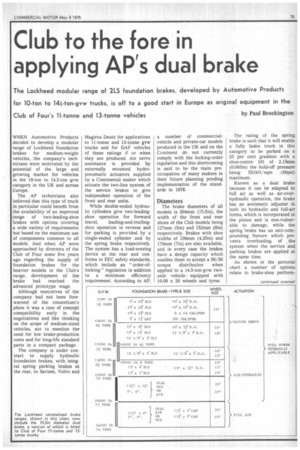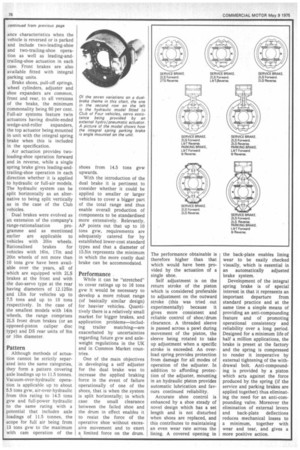Club to the fore in applying AP's dual brake
Page 65

Page 66

If you've noticed an error in this article please click here to report it so we can fix it.
The Lockheed modular range of 215 foundation brakes, developed by Automotive Products for 10-ton to 14a-ton-gvw trucks, is off to a good start in Europe as original equipment in the
Club of Four's 11-tonne and 13-tonne vehicles by Paul Brockington WHEN Automotive Products decided to develop a modular range of Lockheed foundation brakes for medium-weight vehicles, the company's technicians were motivated by the potential of the large and growing market for vehicles in the 10-ton to 14.5-ton gvw category in the UK and across Europe.
The AP technicians also believed that this type of truck in particular could benefit from the availability of an improved range of two-leading-shoe brakes with options covering a wide variety of requirements but based on the maximum use of components common to all models. And when AP were approached by directors of the Club of Four some five years ago regarding the supply of foundation brakes for the heavier models in the Club's range, development of the brake had reached the advanced prototype stage.
Although executives of the company had not been forewarned of the consortium's plans it was a case of concept compatibility early in the negotiations and like thinking on the scope of medium-sized vehicles, not to mention the need for low brake-production costs and for long-life standard parts in a compact package.
The company is under contract to supply hydraulic foundation brakes, with integral spring parking brakes at the rear, to Saviem, Volvo and Magirus Deutz for applications to 11-tonne and 13-tonne gvw trucks and for DAF vehicles of these ratings if or when they are produced. Air servo assistance is provided by externally mounted hydropneumatic actuators supplied by a Continental maker which actuate the two-line system of the service brakes to give independent operation of the front and rear units.
While double-ended hydraulic cylinders give two-leadingshoe operation for forward travel, leading-and-trailingshoe operation in reverse and for parking is provided by a single-ended cylinder and by the spring brake respectively. The system has a load-sensing device at the rear and conforms to EEC safety standards, which include an " order-oflocking " regulation in addition to a minimum efficiency requirement. According to AP, a number of commercialvehicle and private-car models produced in the UK and on the Continent do not currently comply with the locking-order regulation and this shortcoming is said to be the main preoccupation of many makers in their future planning pending implementation of the standards in 1976.
Diameters
The brake diameters of all models is 394mm (15.51n), the width of the front and rear shoes of the Club models being 127nun (5in) and 152nun (6in) respectively. Brakes with shoe widths of 108mm (4.25in) and 170mm (7 in) are also available, and in every case the brakes have a design capacity which enables them to accept a 50/50 torque distribution when applied to a 14.5-ton-gvw twoaxle vehicle equipped with 10.00 x 20 wheels and tyres. The rating of the spring brake is such that it will enable a fully laden truck in this category to be parked on a 25 per cent gradient with a shoe-centre lift of 2.15mm (0.085in) the hold-off pressure being 551kN/sqm (80psi) maximum.
Known as a dual brake because it can be adapted to full air as well as air-overhydraulic operation, the brake has an automatic adjuster in both its hydraulic and full-air forms, which is incorporated in the piston and is non-vulnerable to damage, while the spring brake has an anti-compounding feature which prevents overloading of the system when the service and parking brakes are applied at the same time.
As shown in the pictorial chart a number of options relate to brake-shoe perform ance characteristics when the vehicle is reversed or is parked and include two-leading-shoe and two-trailing-shoe operation as well as leading-andtrailing-shoe actuation in each case. Front brakes are also available fitted with integral parking units.
Brake shoes, pull-off springs, wheel cylinders, adjuster and shoe expanders are common, front and rear, to all versions of the brake, the minimum commonality being 60 per cent. Full-air systems feature twin actuators having double-ended wedge-and-roller expanders, the top actuator being mounted in unit with the integral spring brake when this is included in the specification.
Air actuation provides twoleading-shoe operation forward and in reverse, while a single spring brake gives leading-andtrailing-shoe operation in each direction whether it is applied to hydraulic or full-air models. The hydraulic system can be split horizontally as an alternative to being split vertically as in the case of the Club vehicles.
Dual brakes were evolved as an extension of the company's range-rationalisation programme and as mentioned earlier are applicable to vehicles with 20in wheels.
Rationalised brakes for vehicles with 16in, 17in and 20in wheels of not more than 10 tons gvw have been available over the years, all of which are equipped with 2LS brakes at the front and with the duo-servo type at the rear having diameters of 12.125in and 13in for vehicles up to 7.5 tons and up to 10 tons respectively. In the case of the smallest models with 14in wheels, the range comprises 2LS front drum brakes (or an opposed-piston caliper disc type) and DS rear units of 9in or 10in diameter.
Pattern
Although methods of actuation cannot be strictly separated into the same categories, they form a pattern covering axle loadings up to 11.5 tonnes. Vacuum-over-hydraulic operation is applicable up to about 5.5 tons gvw, air-over-hydraulic from this rating to 14.5 tons gvw and full-power hydraulic to the same rating with a potential that includes axle loadings of 11.5 tonnes, the scope for full air being from 13 tons gvw to the maximum with cam operation of the shoes from 14.5 tons gvw upwards.
With the introduction of the dual brake it is pertinent to consider whether it could be applied to smaller or larger vehicles to cover a bigger part of the total range and thus enable overall production of components to be standardised more extensively. Relevantly, AP points out that up to 10 tons gvw, requirements are adequately catered for by established lower-cost standard types and that a diameter of 15.5in represents the minimum in which the more costly dual brake can be accommodated.
Performance .
While it can be "stretched" to cover ratings up to 16 tons gvw it would be necessary to develop a more robust range (of basically similar design) for heavier vehicles. Quantitively there is a relatively small market for bigger brakes, and application problems—including trailer matching—are exacerbated by uncertainties regarding future gvw and axleweight regulations in the UK and in Common Market countries.
One of the main objectives in developing a self adjuster for the dual brake was to increase the applied braking force in the event of failure operationally of one of the shoes, that is when the system is split horizontally; in which case the small clearance between the failed shoe and the drum in effect enables it to resist the force of the operative shoe without excessive movement and to exert a limited force on the drum. The performance obtainable is therefore higher than that which would have been provided by the actuation of a single shoe.
Self adjustment is on the return stroke of the piston which is considered preferable to adjustment on the outward stroke (this was tried out experimentally) because it gives more consistent and reliable control of shoe/drum clearance. A threaded sleeve is passed across a pawl during movement of the piston, the sleeve being rotated to take up adjustment when a specific stroke is exceeded. An overload spring provides protection from damage for all modes of operation of the adjuster. In addition to affording protection of the adjuster, mounting in an hydraulic piston provides automatic lubrication and favours continued reliability.
Accurate shoe control is enhanced by a shoe steady of novel design which has a set length and is not disturbed when shoes are replaced, and this contributes to maintaining an even wear rate across the lining. A covered opening in the back-plate enables lining wear to be easily checked visually, which is essential in an automatically adjusted brake system.
Development of the integral spring brake is of special interest in that it represents an important departure from standard practice and at the same time a simple means of providing an anti-compounding feature and of promoting operational consistency and reliability over a long period. Designed for a minimum life of half a million applications, the brake is preset at the factory and the spring is compressed to render it inoperative by external tightening of the withdrawal bolt. Anti-compounding is provided by a piston which acts against the force produced by the spring (if the service and parking brakes are applied together) thus eliminating the need for an anti-compounding valve. Moreover the elimination of external levers and back-plate deflections reduces mechanical losses to a minimum, together with wear and tear, and gives a more positive action.




























































































































































